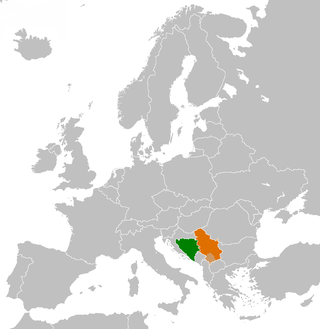Top Qs
Timeline
Chat
Perspective
Bosnia and Herzegovina–Serbia relations
Bilateral relations From Wikipedia, the free encyclopedia
Remove ads
The modern-day countries of Bosnia and Herzegovina and Serbia both originated from Yugoslavia. The majority of the population in both countries speak one of the standard varieties of Serbo-Croatian, and Serbia is one of the largest investors in Bosnia and Herzegovina.
You can help expand this article with text translated from the corresponding article in Serbo-Croatian. (February 2023) Click [show] for important translation instructions.
|
Remove ads
Both countries are full members of the Council of Europe, the Organization for Security and Co-operation in Europe (OSCE), the Central European Free Trade Agreement (CEFTA) and are official candidate states for membership of the European Union.
Remove ads
History
Summarize
Perspective
The beginnings of formal cooperation can be traced to the Bosnian War; Republika Srpska got support from Serbia.[1] At the Dayton Agreement, the President of the Republic of Serbia Slobodan Milošević represented the Bosnian Serb interests due to absence of Radovan Karadžić. The agreement ensured the right for entities in Bosnia and Herzegovina to establish special parallel relationships with neighboring countries consistent with sovereignty and territorial integrity of Bosnia and Herzegovina. The agreement on Special Parallel Relations was signed on February 28, 1997 and implemented December 15, 2010.[2]
On July 8, 2015, Russia vetoed a United Nations Security Council resolution that would have condemned the Srebrenica massacre as a genocide. Lobbied by the Republika Srpska and Serbia, the veto was praised by Serbian President Tomislav Nikolić stating that Russia had "prevented an attempt of smearing the entire Serbian nation as genocidal" and proven itself as a true and honest friend.[3]
Invited by the Bosnian government to attend the annual Srebrenica Genocide Memorial, Serbian Prime Minister Aleksandar Vučić accepted, travelling to Srebrenica on 11 July 2015 to pay his respects. He was attacked by a mob in the crowd with stones, bottles and other objects and had to flee the premise.[4]
In February 2021, Serbia donated 5,000 COVID-19 vaccines to Bosnia and Herzegovina.[5]
List of wars
The Bosnian-Serbian war of 1349[a]–1351[b] was fought between the Banate of Bosnia (Kingdom of Hungary) and the Serbian Empire, and resulted in a Bosnian victory.[6]: 138–140 [7]
The First Serbian Uprising of 1806–1813 was fought between Bosnia Eyalet (Ottoman Empire) and Revolutionary Serbia[c] and resulted in an Ottoman victory.[8][9]: 1, 125 [10]: 119–225
The Bosnian War of 1992–1995 was fought between the Republic of Bosnia and Herzegovina and the Republic of Serbia (Socialist Federal Republic of Yugoslavia),[d] Republic of Serbia (Federal Republic of Yugoslavia)[e] and resulted in a withdrawal of the Yugoslav People's Army.[11]: 85, 86 [12]: 18, 39
Remove ads
Geography
The two countries are located in the western Balkans and Southeastern Europe. They share 357 km of land boundary, partly (206 km) along the Drina.
Economy
Serbia is the second top investor in Bosnia and Herzegovina, according to data spanning May 1994–December 2013.[citation needed]
Culture
Serbs and Bosniaks ethnolinguistically belong to the South Slavic peoples.
Demographics
Serbs of Bosnia and Herzegovina are one of the three constituent nations of Bosnia and Herzegovina along with Bosniaks and Croats. They are the second largest ethnic group, numbering 1,086,733 (30.78%) according to the 2013 census. The community is concentrated in Republika Srpska (numbering 970,857; 82.95%), one of two entities making up BiH. Serbs are predominantly members of the Serbian Orthodox church.
Many Serbs of Bosnia and Herzegovina live in Serbia. Bosniaks of Serbia are a recognized minority of Serbia. They are the fourth largest ethnic group after Serbs, Hungarians and Roma, numbering 145,278 (2.02%) according to the 2011 census.[13] The community is concentrated in the region of Sandžak in southwestern Serbia. Bosniaks are predominantly of Sunni Muslim faith.
Remove ads
Resident diplomatic missions
- Bosnia and Herzegovina has an embassy in Belgrade.
- Serbia has an embassy in Sarajevo and consulates-general in Banja Luka and Mostar and consular offices in Drvar and Trebinje.
- Embassy of Serbia in Sarajevo
- Consulate-General of Serbia in Banja Luka
- Consulate-General of Serbia in Mostar
See also
- Foreign relations of Bosnia and Herzegovina
- Foreign relations of Serbia
- Bosnia and Herzegovina–Kosovo relations
- Agreement on Succession Issues of the Former Socialist Federal Republic of Yugoslavia
- Accession of Bosnia and Herzegovina to the European Union
- Accession of Serbia to the European Union
- Open Balkan
Notes
- "An official Note dated 27 April 1992 from the Permanent Mission of Yugoslavia to the United Nations, addressed to the Secretary-General of the United Nations, stated inter alia that: '... the Socialist Federal Republic of Yugoslavia is transformed into the Federal Republic of Yugoslavia, consisting of the Republic of Serbia and the Republic of Montenegro.'" — ICJ 2007[11]
- "Neither the Republika Srpska, nor the VRS were de jure organs of the FRY, since none of them had the status of organ of that State under its internal law." — ICJ 2007[11]
Remove ads
References
Wikiwand - on
Seamless Wikipedia browsing. On steroids.
Remove ads




